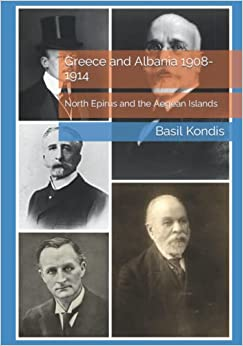BOOK 3410
- Amina Ijaz
- Mar 10, 2023
- 3 min read
Greece and Albania 1908-1914: North Epirus and the Aegean Islands Hardcover – Nov. 30 2022
by Basil Kondis (Author), Dimitrios M Kondis (Editor)
TO BUY THE BOOK PLEASE USE THE FOLLOWING LINK: https://amzn.to/3T8AbOD

SUMMARY OF THE BOOK: The following publication is a digitally enhanced update of the 1976 first edition, originally published by the Institute for Balkan Studies in Thessaloniki, Greece. Since its publication this book has become a reference work for all students and scholars of Albanian History and Greek-Albanian relations. Being out of print and very difficult to find second hand, we had many requests from colleagues and younger students on where they could find and obtain the book.
In 2007 the book was also translated and published in Albanian by Agim I. Tartari without the consent of the author. Subsequent unauthorized editions published in Tirana in 2020 by the Albanian Institute for International Studies have forced the author to make the book available again through printed and e -book editions.
In Addendum I, one can find material regarding the last period of the Greek-Albanian rapprochement program. Part one sheds some light on the secret agreement of January 22, 1907 between Ismail Kemal Bey Vlora and the Greek Government of Giorgos Theotokis. In part two, I have included the secret negotiations between Faik Bey Konitza, and Lysimachos Kavtanzoglou, the Greek charge d'Affaires at Washington, from 1911 to 1912. Kemal and Konitza were "frenemies" with very different views on the rapprochement with Greece: Konitza favored the old concept of the Greco-Albanian dualistic state, while Kemal always envisioned an independent Albania. For the sake of completion, I have included a new chapter regarding the origin and formation of the Balkan League (Chapter 5). This was the only point of criticism from peers at the time of the publication of the first edition, as this is a key moment in Greek-Albanian relationships. After the territorial definition of Albania by the Porte in September 12, 1912, the dream of a “Greater Albania” comprised of the four vilayets (Shkodër, Kosova, Janina and Monastir) was real, although short-lived. This event forced Venizelos' hand to seek a temporary alliance with former enemy Bulgaria. Eventually Greece, Serbia, Montenegro and Bulgaria declared war against the Ottoman Empire and thus the First Balkan War was a reality.
In this book the connection between the Aegean Islands and Northern Epirus was also stressed for the first time. After the Balkan wars, the Greek forces were in control of both the NE Aegean Islands and parts of Northern Epirus. At the London Peace Conference of the Ambassadors during 1912-1913, the two issues were linked by the chair of the conference, the British minister for foreign affairs Edward Grey. Finally Greece in compensation for her loss of Northern Epirus, was to obtain legal recognition of all the Aegean Islands in her possession but accepted to return to Turkey Imbros, Tenedos and Castellorizo. The Dodecanese remained under Italian occupation and were not included in the final exchange. The solution of returning them to Turkey under an autonomous regime proposed by Venizelos and Grey was not realized either. The issue of the Aegean Islands although closely linked with the Albanian issue was not expanded in the first edition as the emphasis was mainly on the effects of the February 13th 1914 decision on Northern Epirus.
In Addendum II, there are three new articles regarding the Aegean Islands at the time of the London Conference of the Ambassadors, which are closely linked and supplement Chapter 7. Part IV includes a selection of important documents from the London P.R.O. dating from 1913 to 1914, which the author could not include in 1976 due to the technological limitations of that time.


Comments